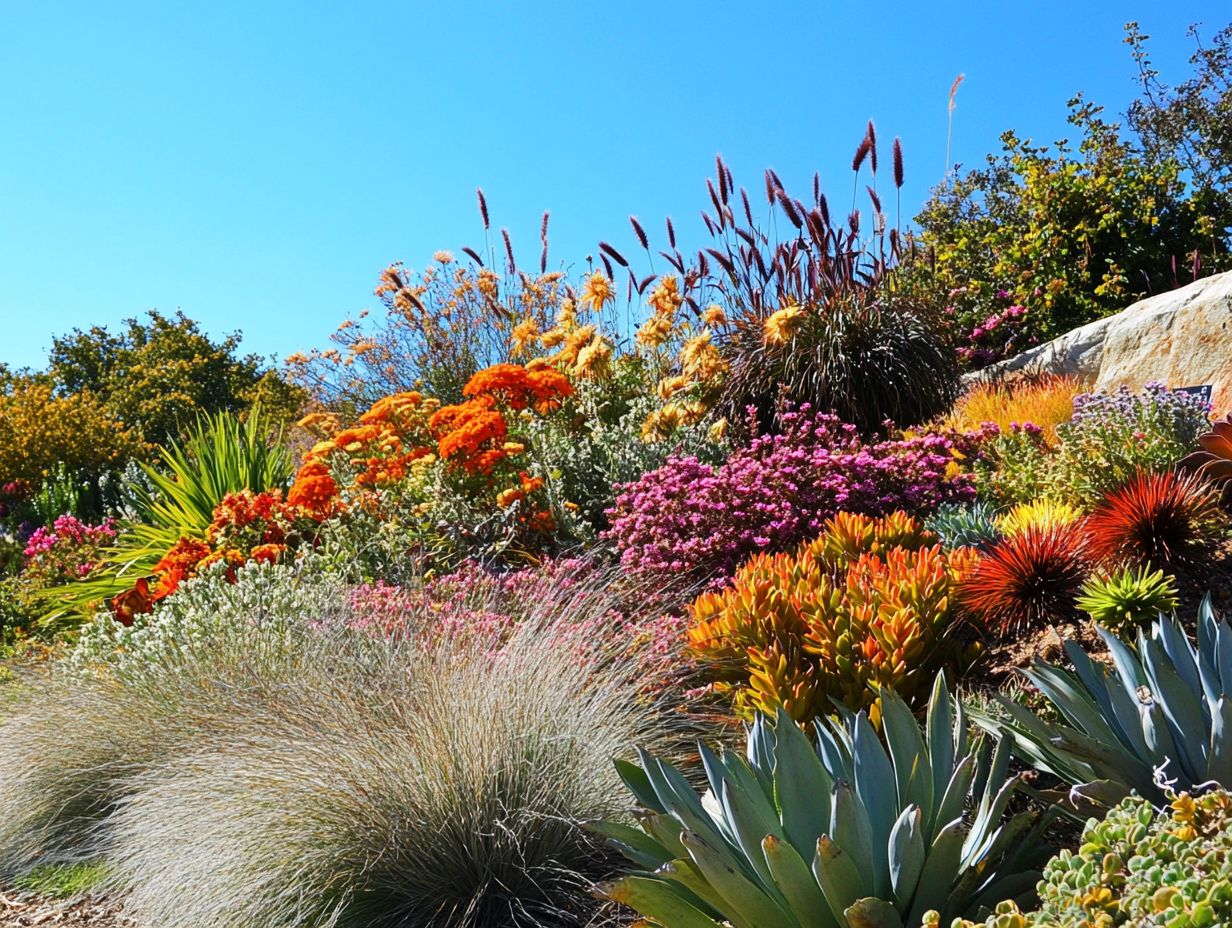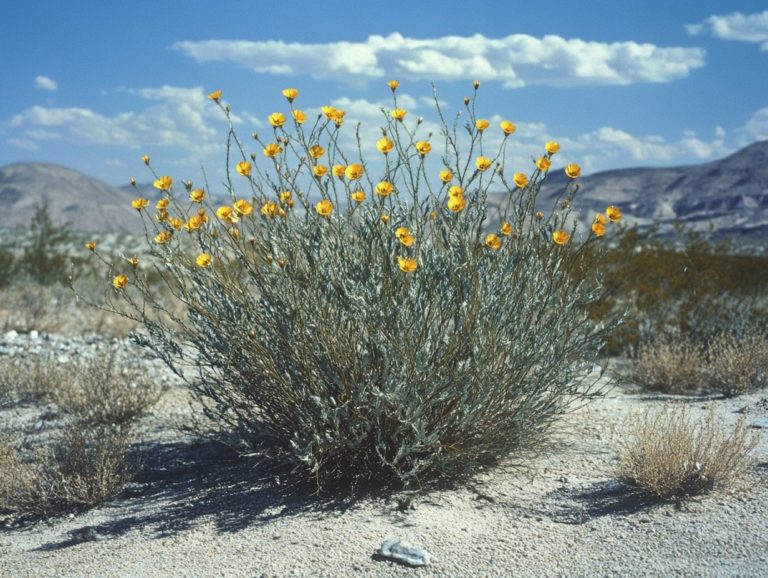How Do I Transition to Drought-Resistant Gardening?
As climate change intensifies, your commitment to sustainable gardening practices has never been more crucial. Embracing drought-resistant gardening not only conserves water but also cultivates a resilient and vibrant landscape that flourishes despite the odds.
This article delves into essential concepts such as water conservation and sustainability. It guides you in assessing your garden’s unique needs and offers a step-by-step blueprint for transitioning to a more drought-tolerant approach.
From selecting the right plants to mastering effective watering techniques, you’ll discover practical tips for nurturing a thriving garden that withstands dry spells.
Explore how you can make a positive impact while reveling in a beautiful, low-maintenance outdoor space.
Contents
- Key Takeaways:
- The Importance of Drought-Resistant Gardening
- Assessing Your Garden’s Needs
- Transitioning to Drought-Resistant Gardening
- Choosing Drought-Resistant Plants
- Watering Techniques for Drought-Resistant Gardens
- Maintaining a Drought-Resistant Garden
- Frequently Asked Questions
- What is drought-resistant gardening?
- Why should I transition to drought-resistant gardening?
- How do I know if a plant is drought-resistant?
- What are some tips for transitioning to drought-resistant gardening?
- Do I need to completely overhaul my garden to transition to drought-resistant gardening?
- Can I still have a beautiful garden with drought-resistant plants?
Key Takeaways:

- Conserving water through drought-resistant gardening is crucial for the environment and sustainability efforts.
- Assessing your current garden’s needs is the first step in transitioning to drought-resistant gardening, taking into account soil, climate, and plant selection.
- Choosing drought-resistant plants and implementing effective watering techniques are key factors in maintaining a successful drought-resistant garden in the long term.
The Importance of Drought-Resistant Gardening
Drought-resistant gardening is essential for cultivating sustainable green landscapes, particularly in areas such as Kamloops. Here, intense heat and water restrictions present significant challenges to conventional gardening methods.
This strategy helps you save water while keeping your garden thriving! It also supports urban ecological health and fosters biodiversity through the incorporation of native species.
By embracing eco-friendly gardening practices, you can bolster food security and craft resilient outdoor spaces that flourish, even in the face of drought concerns.
Understanding Water Conservation and Sustainability
Understanding water conservation and sustainability is crucial for your gardening success, especially if you’re in an area grappling with drought concerns. By implementing strategies like mulch and compost, you can significantly improve soil moisture retention, reducing the need for frequent irrigation.
When you carefully select the right irrigation system tailored to your garden’s specific needs, you can further optimize water usage while keeping your plants vibrant and healthy. For example, using a system that delivers water directly to plant roots saves water and minimizes evaporation and runoff.
Embracing organic practices fosters a thriving ecosystem that naturally enhances soil quality. This leads to gardens that require less maintenance over time. Striking a balance between aesthetics and ecological function is essential; incorporating native plants not only beautifies your garden but also supports local wildlife.
By emphasizing these sustainable practices, you’re not just cultivating a beautiful landscape you re creating a resilient ecosystem that can thrive amidst environmental challenges.
Assessing Your Garden’s Needs
Assessing your garden’s needs is a crucial first step in creating a drought-resistant landscape. By thoughtfully evaluating soil conditions, considering the local climate, and selecting appropriate plants, you can use drought gardening principles in landscaping to customize your outdoor space to flourish even in dry conditions.
This approach not only elevates your garden’s beauty but also enhances its environmental impact. Start transforming your garden today!
Evaluating Soil, Climate, and Plant Selection
Evaluating soil, climate, and plant selection is crucial for cultivating a thriving drought-resistant garden. By understanding soil composition, you can choose plants that are pest-resistant and well-suited to your local climate.
Conducting a thorough soil evaluation allows you to determine the pH (a measure of how acidic or alkaline your soil is), nutrient levels, and texture. This information enables you to tailor your garden to support specific native species.
Consider climate factors such as temperature ranges and rainfall patterns to select plants that thrive with little care.
For example, opting for native species like California lilac or desert marigold enhances your garden’s visual appeal and promotes ecological stability. These plants adapt perfectly to local conditions, providing essential habitats for pollinators while requiring minimal water.
Their natural resistance to local pests reduces the need for chemical treatments, fostering a healthier environment for all garden inhabitants.
Transitioning to Drought-Resistant Gardening

Transitioning to drought-resistant gardening requires careful planning in both landscape design and plant selection. Focus on moisture retention and efficiency.
You can achieve this by implementing effective irrigation systems tailored to meet your garden’s specific needs.
Step-by-Step Guide to Making Changes
Creating a step-by-step guide to transform your garden allows you to systematically implement drought-resistant techniques and enhance the ecological health of your urban environment.
Each step should emphasize the importance of using native plants and efficient watering methods. This deliberate approach conserves water, nurtures local wildlife, boosts biodiversity, and fosters a healthier ecosystem in your neighborhood.
It’s essential to start by assessing the specific environmental factors in your area. Consider soil type and sunlight exposure before selecting suitable drought-tolerant species.
Leverage resources from community seed libraries for access to native seeds and plants that thrive in local conditions while promoting sustainability.
Local workshops, gardening groups, and online forums act as invaluable support networks, sharing practical insights for effective garden management.
Engage with these resources to cultivate sustainable practices that thrive, even in challenging climates. Start your journey today by visiting a local seed library or joining a gardening group!
Choosing Drought-Resistant Plants
Choosing drought-resistant plants is vital for cultivating a sustainable, low-maintenance garden. Select native species and suitable flowering plants to enhance your garden’s resilience against drought conditions.
Types of Plants to Consider
When exploring options for drought-resistant gardening, consider native species like the American Mountain Ash, Ponderosa Pine, and Silverberry Tree. These plants thrive in local conditions and enhance the ecosystem.
Additionally, a selection of drought-tolerant shrubs and perennials can elevate your garden’s resilience and aesthetic charm. Take Lavender, for example; its delightful fragrance attracts bees and butterflies, enriching biodiversity.
Succulents are also excellent choices, with their striking geometric shapes designed to store water, making them perfect for dry climates.
Incorporating native wildflowers like Coneflower and Blanket Flower adds vibrant color while supporting local wildlife and requiring minimal upkeep.
Together, these plants enhance soil health and promote a sustainable environment, proving that even in arid regions, a thriving garden is well within your reach.
Watering Techniques for Drought-Resistant Gardens
Implementing effective watering techniques is essential for cultivating a drought-resistant garden, especially in regions facing drought challenges. By utilizing efficient irrigation systems, you can achieve notable reductions in your water bills while ensuring that your plants receive the optimal moisture they need to thrive.
Effective Strategies for Water Conservation

Adopting effective strategies for water conservation is vital for your success in drought-resistant gardening. Techniques like applying mulch and compost can greatly enhance soil health and improve moisture retention, and learning how to enhance drought resistance in existing gardens can further boost your efforts.
Consider utilizing drip irrigation systems. This approach allows you to target plants directly, minimizing water waste while ensuring they receive the hydration they need.
Selecting native and drought-tolerant plants is a savvy landscaping choice that helps reduce overall water consumption in your garden. Incorporating rain barrels helps you collect and reuse rainwater, further enriching your eco-friendly gardening efforts.
Grouping plants with similar watering needs optimizes your irrigation practices and fosters a healthy variety of plants and animals in your garden. These sustainable strategies contribute to a healthier ecosystem, ensuring your garden remains vibrant even in the driest seasons!
Maintaining a Drought-Resistant Garden
Maintaining a drought-resistant garden requires a commitment to ongoing practices that ensure sustainability and resilience. For guidance, you can explore best practices for drought-resistant gardening, which positions it as a low-maintenance choice for any gardener.
By integrating pest resistance strategies and fostering a wildlife habitat, you enable your garden to flourish, even in the most challenging conditions.
Tips for Long-Term Success
Implementing strategies for long-term success in drought-resistant gardening ensures your efforts sustain healthy ecosystems while contributing to food preservation. Engaging with community seed libraries can provide you with invaluable resources, helping you maintain resilient gardens.
Join local gardening groups to share tips and learn from others. Practicing adaptive gardening methods, like mulching and planting native species, conserves water while enhancing soil health an essential element for thriving ecosystems.
By actively participating in workshops and community events, you cultivate a supportive network, sharing your experiences and celebrating your successes. Involving schools in gardening projects can inspire the next generation to appreciate and care for the environment, fostering a sustainable cycle of ecological respect and awareness.
Frequently Asked Questions
What is drought-resistant gardening?
So, what is drought-resistant gardening? It’s all about using plants that need less water and can thrive in dry conditions, which you can learn more about in this guide on how to create a drought-resistant garden.
Why should I transition to drought-resistant gardening?

Transitioning to drought-resistant gardening helps conserve water and saves you money on your water bill. For tips on creating a sustainable drought garden, it also supports the environment by reducing the strain on local water resources!
How do I know if a plant is drought-resistant?
Drought-resistant plants typically have adaptations that help them survive with minimal water, like deep root systems, small leaves, or waxy coatings. Look for plants native to your region, as they are more likely to thrive in local climate conditions.
What are some tips for transitioning to drought-resistant gardening?
Start by assessing your current landscaping and identifying areas that require the most water. Gradually replace high-water plants with drought-resistant varieties and incorporate techniques for designing a drought-resistant landscape, like using mulch and drip irrigation, to help conserve water.
Do I need to completely overhaul my garden to transition to drought-resistant gardening?
No, you don t have to start from scratch.
Begin by replacing high-water plants with drought-tolerant varieties.
Incorporate water-saving techniques gradually as you enhance your garden.
Can I still have a beautiful garden with drought-resistant plants?
Absolutely! Plants like lavender, succulents, and California poppies add beauty and color.
With careful planning, you can create a stunning garden while conserving water.






